Workplace Health Promotion Analysis: Agha Khan Hospital, Pakistan
VerifiedAdded on 2023/06/11
|13
|3686
|149
Report
AI Summary
This report assesses the workplace health promotion strategies at Agha Khan Hospital in Karachi, Pakistan, using the Ottawa Charter framework. It identifies existing health policies, supportive environments, community action, personal skill development, and healthcare service reorientation initiatives within the hospital. The report evaluates the effectiveness of these strategies, highlighting strengths such as stress management lectures, wellness improvement models, gym facilities, and employee support programs. It also addresses areas for improvement, including flexible work options, enhanced socialization opportunities, and stricter enforcement of non-smoking policies. Recommendations are made for incorporating yoga classes, standing workstations, flexible work hours, and healthier eating programs to further enhance employee wellbeing. The analysis incorporates insights from employee experiences to provide a comprehensive overview of health promotion practices at Agha Khan Hospital.
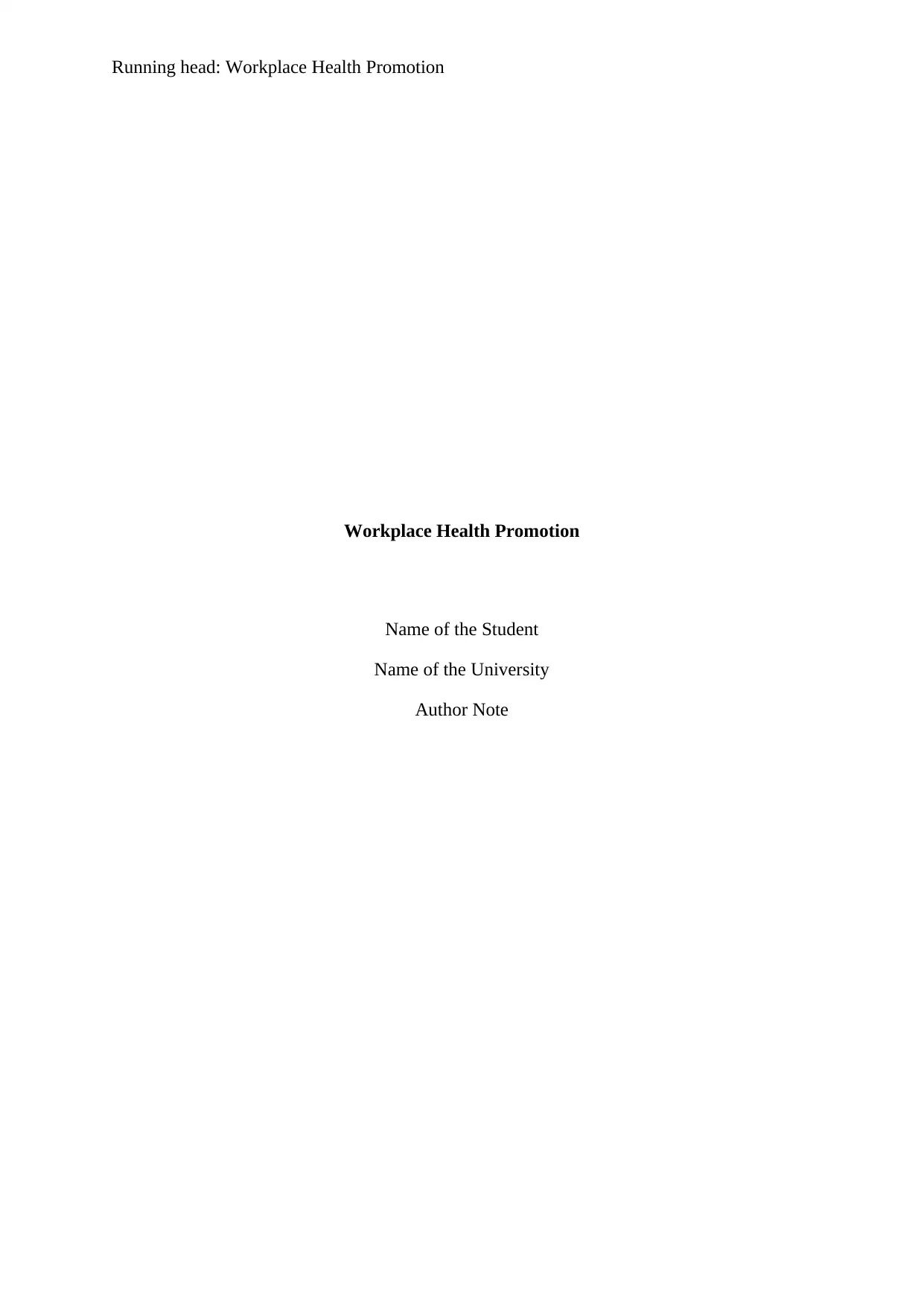
Running head: Workplace Health Promotion
Workplace Health Promotion
Name of the Student
Name of the University
Author Note
Workplace Health Promotion
Name of the Student
Name of the University
Author Note
Paraphrase This Document
Need a fresh take? Get an instant paraphrase of this document with our AI Paraphraser
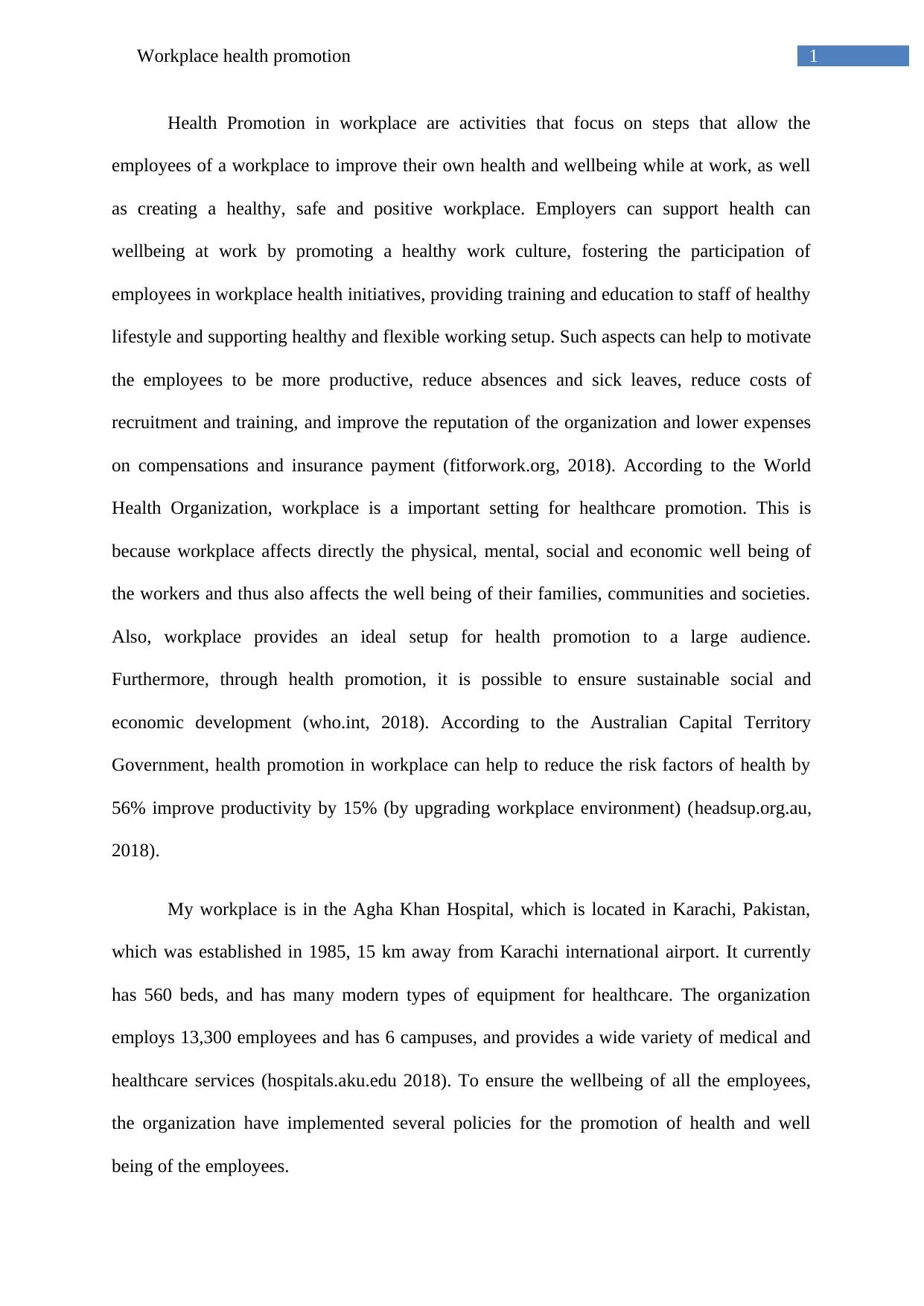
1Workplace health promotion
Health Promotion in workplace are activities that focus on steps that allow the
employees of a workplace to improve their own health and wellbeing while at work, as well
as creating a healthy, safe and positive workplace. Employers can support health can
wellbeing at work by promoting a healthy work culture, fostering the participation of
employees in workplace health initiatives, providing training and education to staff of healthy
lifestyle and supporting healthy and flexible working setup. Such aspects can help to motivate
the employees to be more productive, reduce absences and sick leaves, reduce costs of
recruitment and training, and improve the reputation of the organization and lower expenses
on compensations and insurance payment (fitforwork.org, 2018). According to the World
Health Organization, workplace is a important setting for healthcare promotion. This is
because workplace affects directly the physical, mental, social and economic well being of
the workers and thus also affects the well being of their families, communities and societies.
Also, workplace provides an ideal setup for health promotion to a large audience.
Furthermore, through health promotion, it is possible to ensure sustainable social and
economic development (who.int, 2018). According to the Australian Capital Territory
Government, health promotion in workplace can help to reduce the risk factors of health by
56% improve productivity by 15% (by upgrading workplace environment) (headsup.org.au,
2018).
My workplace is in the Agha Khan Hospital, which is located in Karachi, Pakistan,
which was established in 1985, 15 km away from Karachi international airport. It currently
has 560 beds, and has many modern types of equipment for healthcare. The organization
employs 13,300 employees and has 6 campuses, and provides a wide variety of medical and
healthcare services (hospitals.aku.edu 2018). To ensure the wellbeing of all the employees,
the organization have implemented several policies for the promotion of health and well
being of the employees.
Health Promotion in workplace are activities that focus on steps that allow the
employees of a workplace to improve their own health and wellbeing while at work, as well
as creating a healthy, safe and positive workplace. Employers can support health can
wellbeing at work by promoting a healthy work culture, fostering the participation of
employees in workplace health initiatives, providing training and education to staff of healthy
lifestyle and supporting healthy and flexible working setup. Such aspects can help to motivate
the employees to be more productive, reduce absences and sick leaves, reduce costs of
recruitment and training, and improve the reputation of the organization and lower expenses
on compensations and insurance payment (fitforwork.org, 2018). According to the World
Health Organization, workplace is a important setting for healthcare promotion. This is
because workplace affects directly the physical, mental, social and economic well being of
the workers and thus also affects the well being of their families, communities and societies.
Also, workplace provides an ideal setup for health promotion to a large audience.
Furthermore, through health promotion, it is possible to ensure sustainable social and
economic development (who.int, 2018). According to the Australian Capital Territory
Government, health promotion in workplace can help to reduce the risk factors of health by
56% improve productivity by 15% (by upgrading workplace environment) (headsup.org.au,
2018).
My workplace is in the Agha Khan Hospital, which is located in Karachi, Pakistan,
which was established in 1985, 15 km away from Karachi international airport. It currently
has 560 beds, and has many modern types of equipment for healthcare. The organization
employs 13,300 employees and has 6 campuses, and provides a wide variety of medical and
healthcare services (hospitals.aku.edu 2018). To ensure the wellbeing of all the employees,
the organization have implemented several policies for the promotion of health and well
being of the employees.
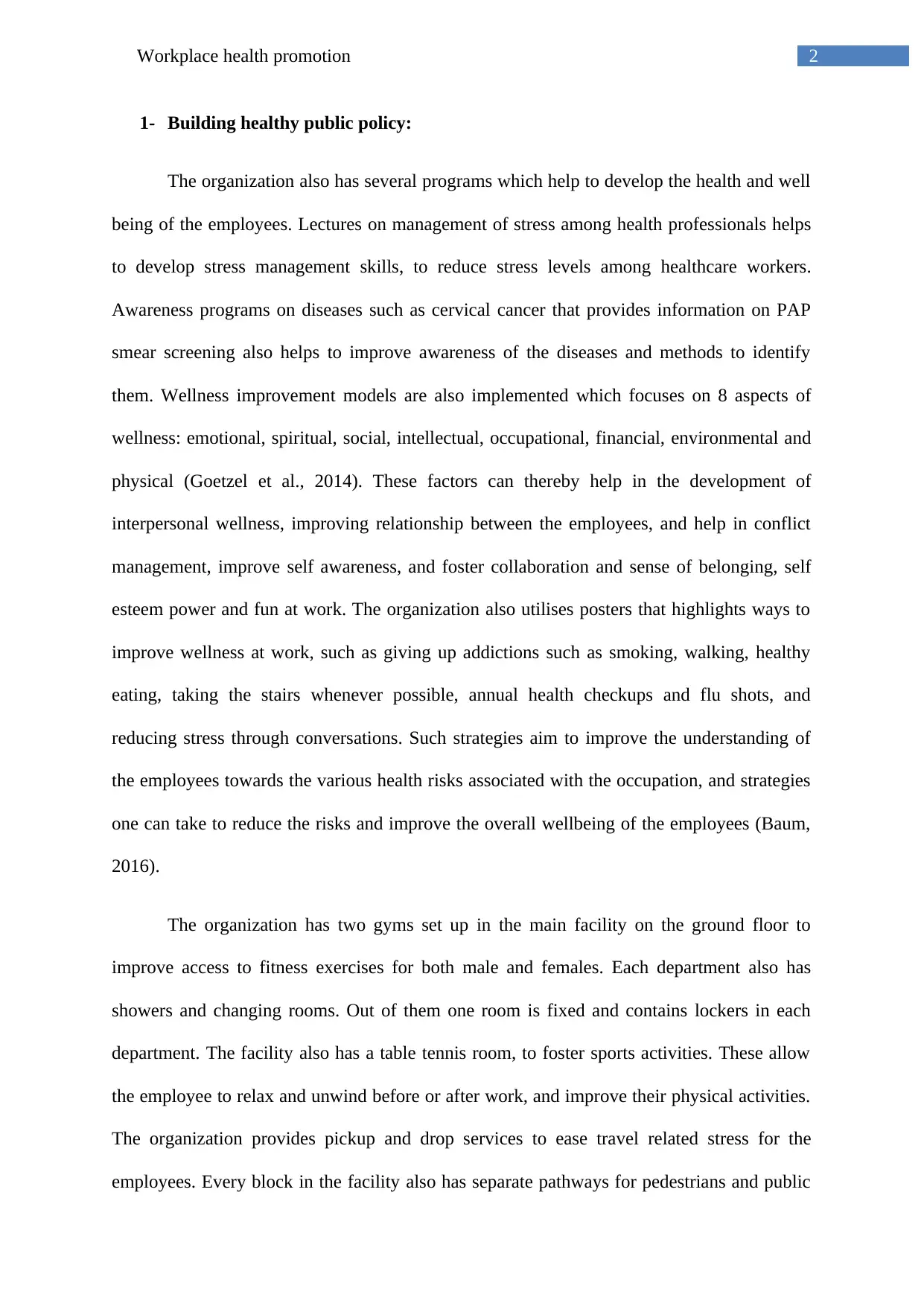
2Workplace health promotion
1- Building healthy public policy:
The organization also has several programs which help to develop the health and well
being of the employees. Lectures on management of stress among health professionals helps
to develop stress management skills, to reduce stress levels among healthcare workers.
Awareness programs on diseases such as cervical cancer that provides information on PAP
smear screening also helps to improve awareness of the diseases and methods to identify
them. Wellness improvement models are also implemented which focuses on 8 aspects of
wellness: emotional, spiritual, social, intellectual, occupational, financial, environmental and
physical (Goetzel et al., 2014). These factors can thereby help in the development of
interpersonal wellness, improving relationship between the employees, and help in conflict
management, improve self awareness, and foster collaboration and sense of belonging, self
esteem power and fun at work. The organization also utilises posters that highlights ways to
improve wellness at work, such as giving up addictions such as smoking, walking, healthy
eating, taking the stairs whenever possible, annual health checkups and flu shots, and
reducing stress through conversations. Such strategies aim to improve the understanding of
the employees towards the various health risks associated with the occupation, and strategies
one can take to reduce the risks and improve the overall wellbeing of the employees (Baum,
2016).
The organization has two gyms set up in the main facility on the ground floor to
improve access to fitness exercises for both male and females. Each department also has
showers and changing rooms. Out of them one room is fixed and contains lockers in each
department. The facility also has a table tennis room, to foster sports activities. These allow
the employee to relax and unwind before or after work, and improve their physical activities.
The organization provides pickup and drop services to ease travel related stress for the
employees. Every block in the facility also has separate pathways for pedestrians and public
1- Building healthy public policy:
The organization also has several programs which help to develop the health and well
being of the employees. Lectures on management of stress among health professionals helps
to develop stress management skills, to reduce stress levels among healthcare workers.
Awareness programs on diseases such as cervical cancer that provides information on PAP
smear screening also helps to improve awareness of the diseases and methods to identify
them. Wellness improvement models are also implemented which focuses on 8 aspects of
wellness: emotional, spiritual, social, intellectual, occupational, financial, environmental and
physical (Goetzel et al., 2014). These factors can thereby help in the development of
interpersonal wellness, improving relationship between the employees, and help in conflict
management, improve self awareness, and foster collaboration and sense of belonging, self
esteem power and fun at work. The organization also utilises posters that highlights ways to
improve wellness at work, such as giving up addictions such as smoking, walking, healthy
eating, taking the stairs whenever possible, annual health checkups and flu shots, and
reducing stress through conversations. Such strategies aim to improve the understanding of
the employees towards the various health risks associated with the occupation, and strategies
one can take to reduce the risks and improve the overall wellbeing of the employees (Baum,
2016).
The organization has two gyms set up in the main facility on the ground floor to
improve access to fitness exercises for both male and females. Each department also has
showers and changing rooms. Out of them one room is fixed and contains lockers in each
department. The facility also has a table tennis room, to foster sports activities. These allow
the employee to relax and unwind before or after work, and improve their physical activities.
The organization provides pickup and drop services to ease travel related stress for the
employees. Every block in the facility also has separate pathways for pedestrians and public
⊘ This is a preview!⊘
Do you want full access?
Subscribe today to unlock all pages.

Trusted by 1+ million students worldwide
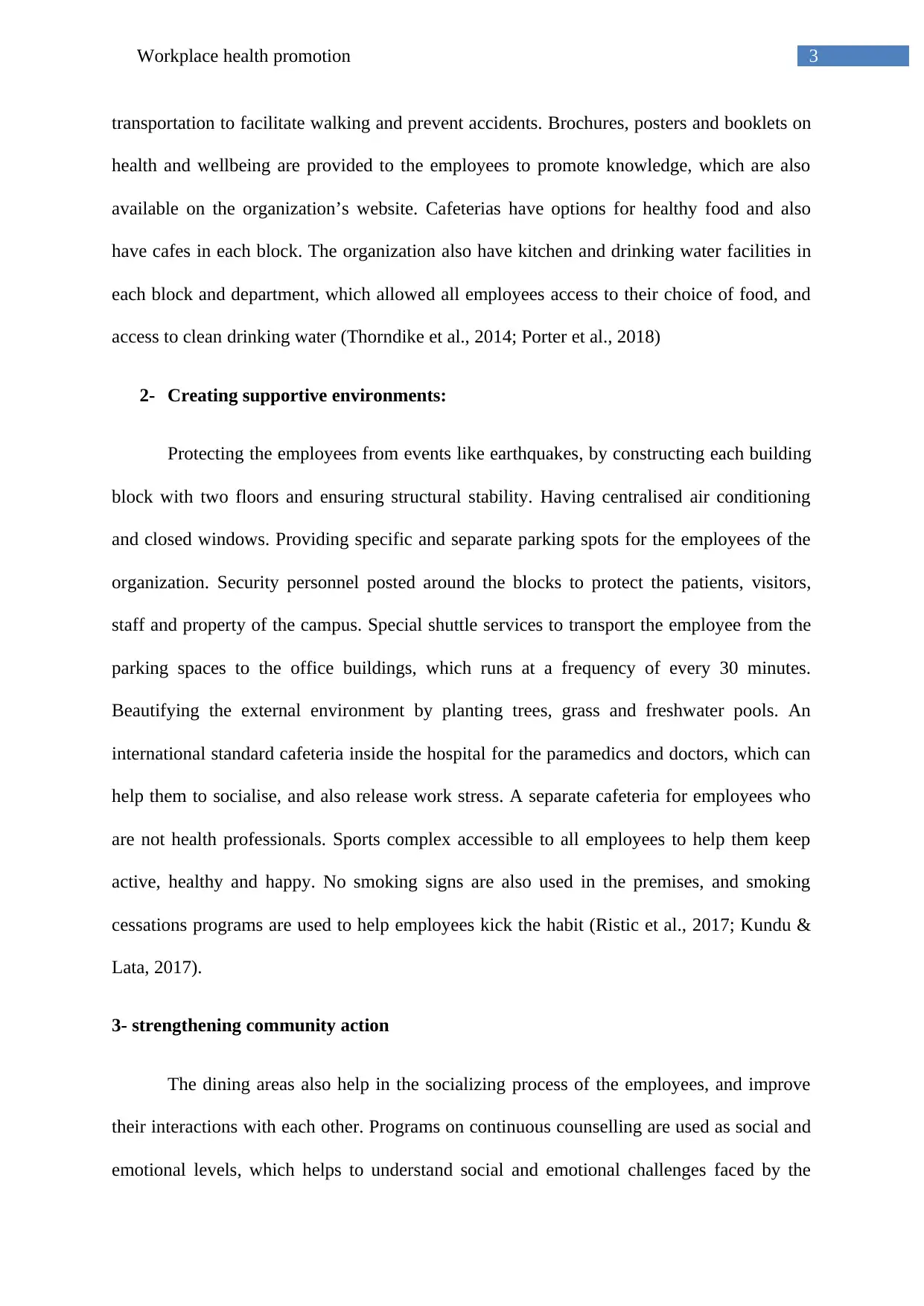
3Workplace health promotion
transportation to facilitate walking and prevent accidents. Brochures, posters and booklets on
health and wellbeing are provided to the employees to promote knowledge, which are also
available on the organization’s website. Cafeterias have options for healthy food and also
have cafes in each block. The organization also have kitchen and drinking water facilities in
each block and department, which allowed all employees access to their choice of food, and
access to clean drinking water (Thorndike et al., 2014; Porter et al., 2018)
2- Creating supportive environments:
Protecting the employees from events like earthquakes, by constructing each building
block with two floors and ensuring structural stability. Having centralised air conditioning
and closed windows. Providing specific and separate parking spots for the employees of the
organization. Security personnel posted around the blocks to protect the patients, visitors,
staff and property of the campus. Special shuttle services to transport the employee from the
parking spaces to the office buildings, which runs at a frequency of every 30 minutes.
Beautifying the external environment by planting trees, grass and freshwater pools. An
international standard cafeteria inside the hospital for the paramedics and doctors, which can
help them to socialise, and also release work stress. A separate cafeteria for employees who
are not health professionals. Sports complex accessible to all employees to help them keep
active, healthy and happy. No smoking signs are also used in the premises, and smoking
cessations programs are used to help employees kick the habit (Ristic et al., 2017; Kundu &
Lata, 2017).
3- strengthening community action
The dining areas also help in the socializing process of the employees, and improve
their interactions with each other. Programs on continuous counselling are used as social and
emotional levels, which helps to understand social and emotional challenges faced by the
transportation to facilitate walking and prevent accidents. Brochures, posters and booklets on
health and wellbeing are provided to the employees to promote knowledge, which are also
available on the organization’s website. Cafeterias have options for healthy food and also
have cafes in each block. The organization also have kitchen and drinking water facilities in
each block and department, which allowed all employees access to their choice of food, and
access to clean drinking water (Thorndike et al., 2014; Porter et al., 2018)
2- Creating supportive environments:
Protecting the employees from events like earthquakes, by constructing each building
block with two floors and ensuring structural stability. Having centralised air conditioning
and closed windows. Providing specific and separate parking spots for the employees of the
organization. Security personnel posted around the blocks to protect the patients, visitors,
staff and property of the campus. Special shuttle services to transport the employee from the
parking spaces to the office buildings, which runs at a frequency of every 30 minutes.
Beautifying the external environment by planting trees, grass and freshwater pools. An
international standard cafeteria inside the hospital for the paramedics and doctors, which can
help them to socialise, and also release work stress. A separate cafeteria for employees who
are not health professionals. Sports complex accessible to all employees to help them keep
active, healthy and happy. No smoking signs are also used in the premises, and smoking
cessations programs are used to help employees kick the habit (Ristic et al., 2017; Kundu &
Lata, 2017).
3- strengthening community action
The dining areas also help in the socializing process of the employees, and improve
their interactions with each other. Programs on continuous counselling are used as social and
emotional levels, which helps to understand social and emotional challenges faced by the
Paraphrase This Document
Need a fresh take? Get an instant paraphrase of this document with our AI Paraphraser
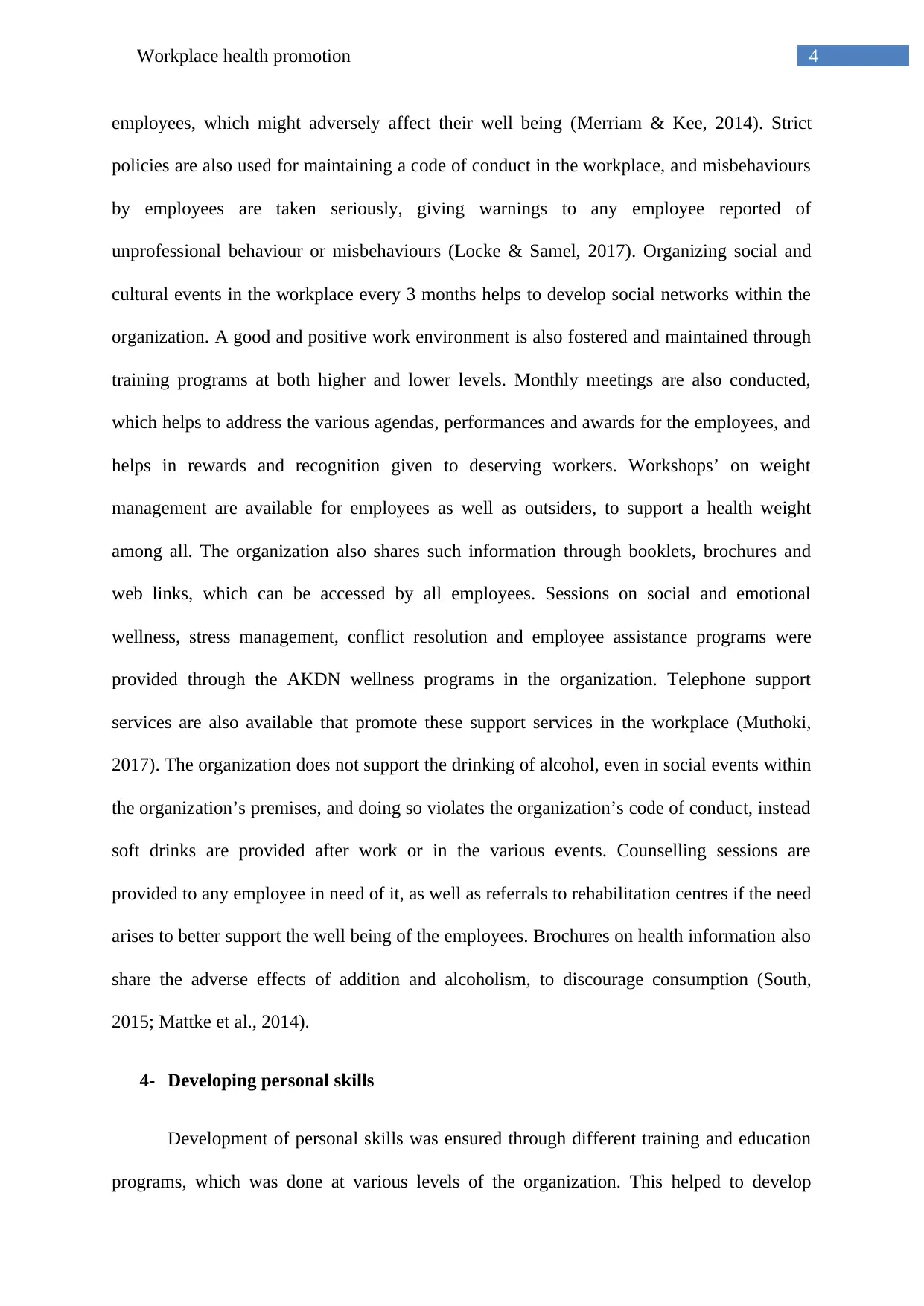
4Workplace health promotion
employees, which might adversely affect their well being (Merriam & Kee, 2014). Strict
policies are also used for maintaining a code of conduct in the workplace, and misbehaviours
by employees are taken seriously, giving warnings to any employee reported of
unprofessional behaviour or misbehaviours (Locke & Samel, 2017). Organizing social and
cultural events in the workplace every 3 months helps to develop social networks within the
organization. A good and positive work environment is also fostered and maintained through
training programs at both higher and lower levels. Monthly meetings are also conducted,
which helps to address the various agendas, performances and awards for the employees, and
helps in rewards and recognition given to deserving workers. Workshops’ on weight
management are available for employees as well as outsiders, to support a health weight
among all. The organization also shares such information through booklets, brochures and
web links, which can be accessed by all employees. Sessions on social and emotional
wellness, stress management, conflict resolution and employee assistance programs were
provided through the AKDN wellness programs in the organization. Telephone support
services are also available that promote these support services in the workplace (Muthoki,
2017). The organization does not support the drinking of alcohol, even in social events within
the organization’s premises, and doing so violates the organization’s code of conduct, instead
soft drinks are provided after work or in the various events. Counselling sessions are
provided to any employee in need of it, as well as referrals to rehabilitation centres if the need
arises to better support the well being of the employees. Brochures on health information also
share the adverse effects of addition and alcoholism, to discourage consumption (South,
2015; Mattke et al., 2014).
4- Developing personal skills
Development of personal skills was ensured through different training and education
programs, which was done at various levels of the organization. This helped to develop
employees, which might adversely affect their well being (Merriam & Kee, 2014). Strict
policies are also used for maintaining a code of conduct in the workplace, and misbehaviours
by employees are taken seriously, giving warnings to any employee reported of
unprofessional behaviour or misbehaviours (Locke & Samel, 2017). Organizing social and
cultural events in the workplace every 3 months helps to develop social networks within the
organization. A good and positive work environment is also fostered and maintained through
training programs at both higher and lower levels. Monthly meetings are also conducted,
which helps to address the various agendas, performances and awards for the employees, and
helps in rewards and recognition given to deserving workers. Workshops’ on weight
management are available for employees as well as outsiders, to support a health weight
among all. The organization also shares such information through booklets, brochures and
web links, which can be accessed by all employees. Sessions on social and emotional
wellness, stress management, conflict resolution and employee assistance programs were
provided through the AKDN wellness programs in the organization. Telephone support
services are also available that promote these support services in the workplace (Muthoki,
2017). The organization does not support the drinking of alcohol, even in social events within
the organization’s premises, and doing so violates the organization’s code of conduct, instead
soft drinks are provided after work or in the various events. Counselling sessions are
provided to any employee in need of it, as well as referrals to rehabilitation centres if the need
arises to better support the well being of the employees. Brochures on health information also
share the adverse effects of addition and alcoholism, to discourage consumption (South,
2015; Mattke et al., 2014).
4- Developing personal skills
Development of personal skills was ensured through different training and education
programs, which was done at various levels of the organization. This helped to develop
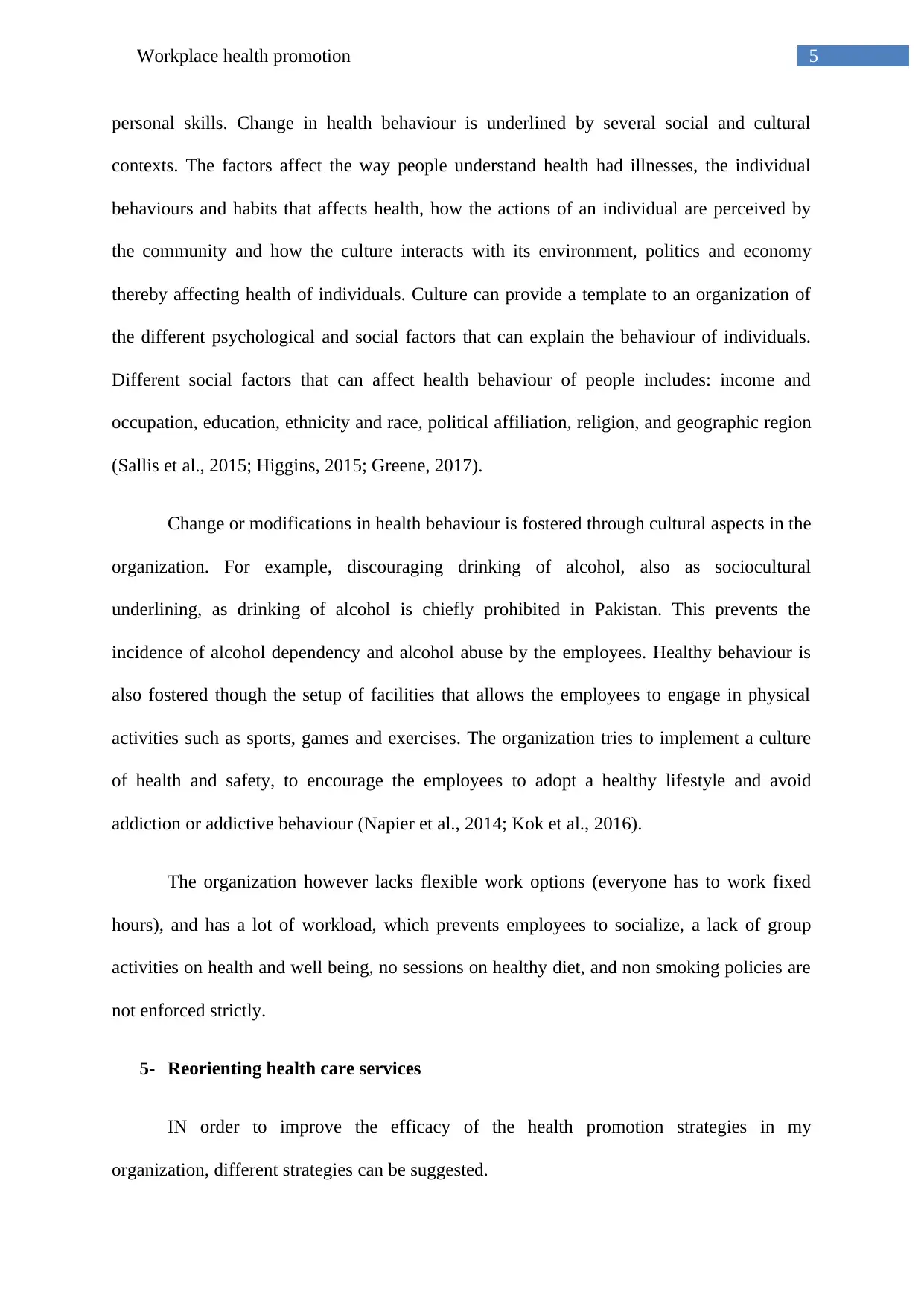
5Workplace health promotion
personal skills. Change in health behaviour is underlined by several social and cultural
contexts. The factors affect the way people understand health had illnesses, the individual
behaviours and habits that affects health, how the actions of an individual are perceived by
the community and how the culture interacts with its environment, politics and economy
thereby affecting health of individuals. Culture can provide a template to an organization of
the different psychological and social factors that can explain the behaviour of individuals.
Different social factors that can affect health behaviour of people includes: income and
occupation, education, ethnicity and race, political affiliation, religion, and geographic region
(Sallis et al., 2015; Higgins, 2015; Greene, 2017).
Change or modifications in health behaviour is fostered through cultural aspects in the
organization. For example, discouraging drinking of alcohol, also as sociocultural
underlining, as drinking of alcohol is chiefly prohibited in Pakistan. This prevents the
incidence of alcohol dependency and alcohol abuse by the employees. Healthy behaviour is
also fostered though the setup of facilities that allows the employees to engage in physical
activities such as sports, games and exercises. The organization tries to implement a culture
of health and safety, to encourage the employees to adopt a healthy lifestyle and avoid
addiction or addictive behaviour (Napier et al., 2014; Kok et al., 2016).
The organization however lacks flexible work options (everyone has to work fixed
hours), and has a lot of workload, which prevents employees to socialize, a lack of group
activities on health and well being, no sessions on healthy diet, and non smoking policies are
not enforced strictly.
5- Reorienting health care services
IN order to improve the efficacy of the health promotion strategies in my
organization, different strategies can be suggested.
personal skills. Change in health behaviour is underlined by several social and cultural
contexts. The factors affect the way people understand health had illnesses, the individual
behaviours and habits that affects health, how the actions of an individual are perceived by
the community and how the culture interacts with its environment, politics and economy
thereby affecting health of individuals. Culture can provide a template to an organization of
the different psychological and social factors that can explain the behaviour of individuals.
Different social factors that can affect health behaviour of people includes: income and
occupation, education, ethnicity and race, political affiliation, religion, and geographic region
(Sallis et al., 2015; Higgins, 2015; Greene, 2017).
Change or modifications in health behaviour is fostered through cultural aspects in the
organization. For example, discouraging drinking of alcohol, also as sociocultural
underlining, as drinking of alcohol is chiefly prohibited in Pakistan. This prevents the
incidence of alcohol dependency and alcohol abuse by the employees. Healthy behaviour is
also fostered though the setup of facilities that allows the employees to engage in physical
activities such as sports, games and exercises. The organization tries to implement a culture
of health and safety, to encourage the employees to adopt a healthy lifestyle and avoid
addiction or addictive behaviour (Napier et al., 2014; Kok et al., 2016).
The organization however lacks flexible work options (everyone has to work fixed
hours), and has a lot of workload, which prevents employees to socialize, a lack of group
activities on health and well being, no sessions on healthy diet, and non smoking policies are
not enforced strictly.
5- Reorienting health care services
IN order to improve the efficacy of the health promotion strategies in my
organization, different strategies can be suggested.
⊘ This is a preview!⊘
Do you want full access?
Subscribe today to unlock all pages.

Trusted by 1+ million students worldwide
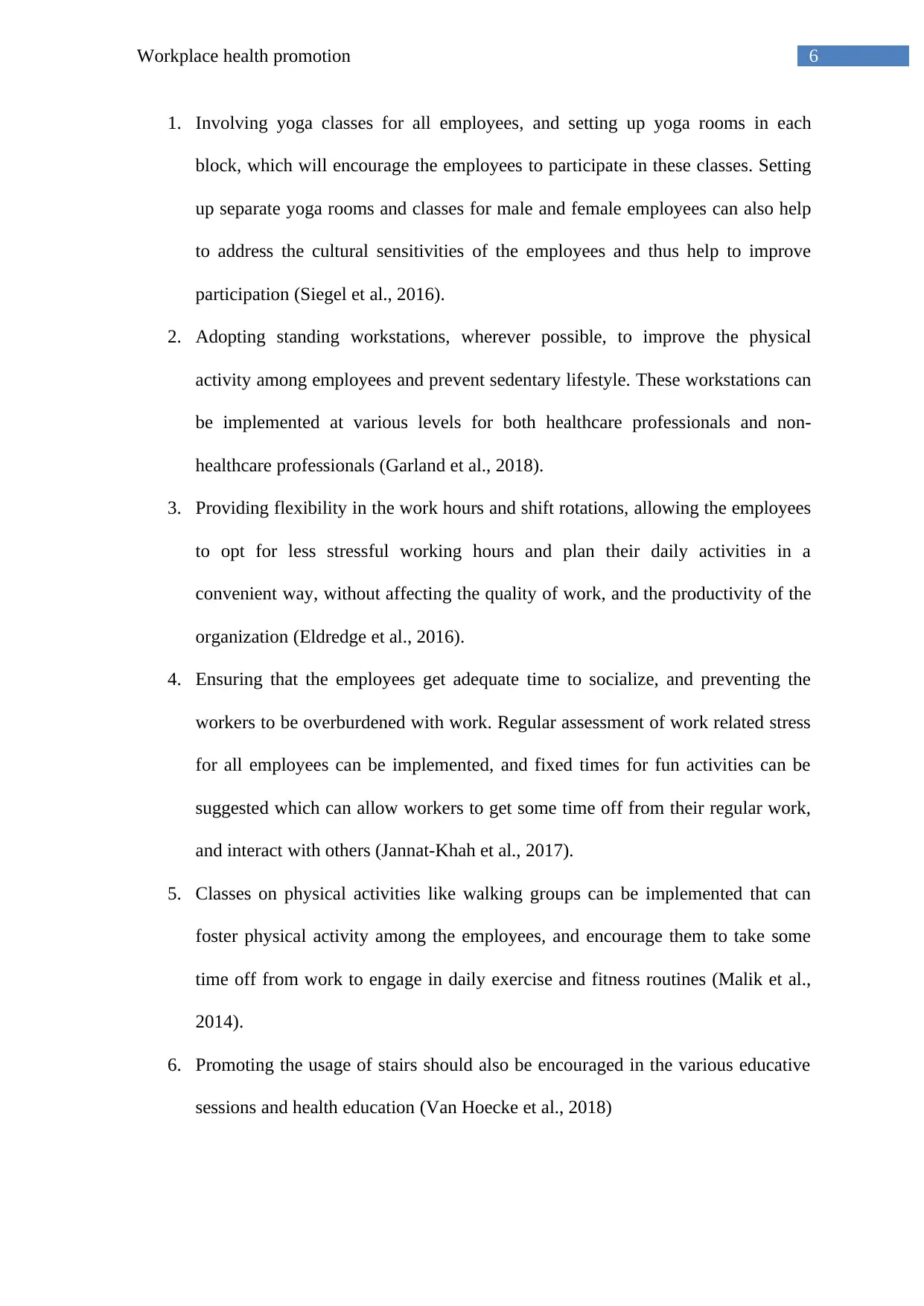
6Workplace health promotion
1. Involving yoga classes for all employees, and setting up yoga rooms in each
block, which will encourage the employees to participate in these classes. Setting
up separate yoga rooms and classes for male and female employees can also help
to address the cultural sensitivities of the employees and thus help to improve
participation (Siegel et al., 2016).
2. Adopting standing workstations, wherever possible, to improve the physical
activity among employees and prevent sedentary lifestyle. These workstations can
be implemented at various levels for both healthcare professionals and non-
healthcare professionals (Garland et al., 2018).
3. Providing flexibility in the work hours and shift rotations, allowing the employees
to opt for less stressful working hours and plan their daily activities in a
convenient way, without affecting the quality of work, and the productivity of the
organization (Eldredge et al., 2016).
4. Ensuring that the employees get adequate time to socialize, and preventing the
workers to be overburdened with work. Regular assessment of work related stress
for all employees can be implemented, and fixed times for fun activities can be
suggested which can allow workers to get some time off from their regular work,
and interact with others (Jannat-Khah et al., 2017).
5. Classes on physical activities like walking groups can be implemented that can
foster physical activity among the employees, and encourage them to take some
time off from work to engage in daily exercise and fitness routines (Malik et al.,
2014).
6. Promoting the usage of stairs should also be encouraged in the various educative
sessions and health education (Van Hoecke et al., 2018)
1. Involving yoga classes for all employees, and setting up yoga rooms in each
block, which will encourage the employees to participate in these classes. Setting
up separate yoga rooms and classes for male and female employees can also help
to address the cultural sensitivities of the employees and thus help to improve
participation (Siegel et al., 2016).
2. Adopting standing workstations, wherever possible, to improve the physical
activity among employees and prevent sedentary lifestyle. These workstations can
be implemented at various levels for both healthcare professionals and non-
healthcare professionals (Garland et al., 2018).
3. Providing flexibility in the work hours and shift rotations, allowing the employees
to opt for less stressful working hours and plan their daily activities in a
convenient way, without affecting the quality of work, and the productivity of the
organization (Eldredge et al., 2016).
4. Ensuring that the employees get adequate time to socialize, and preventing the
workers to be overburdened with work. Regular assessment of work related stress
for all employees can be implemented, and fixed times for fun activities can be
suggested which can allow workers to get some time off from their regular work,
and interact with others (Jannat-Khah et al., 2017).
5. Classes on physical activities like walking groups can be implemented that can
foster physical activity among the employees, and encourage them to take some
time off from work to engage in daily exercise and fitness routines (Malik et al.,
2014).
6. Promoting the usage of stairs should also be encouraged in the various educative
sessions and health education (Van Hoecke et al., 2018)
Paraphrase This Document
Need a fresh take? Get an instant paraphrase of this document with our AI Paraphraser
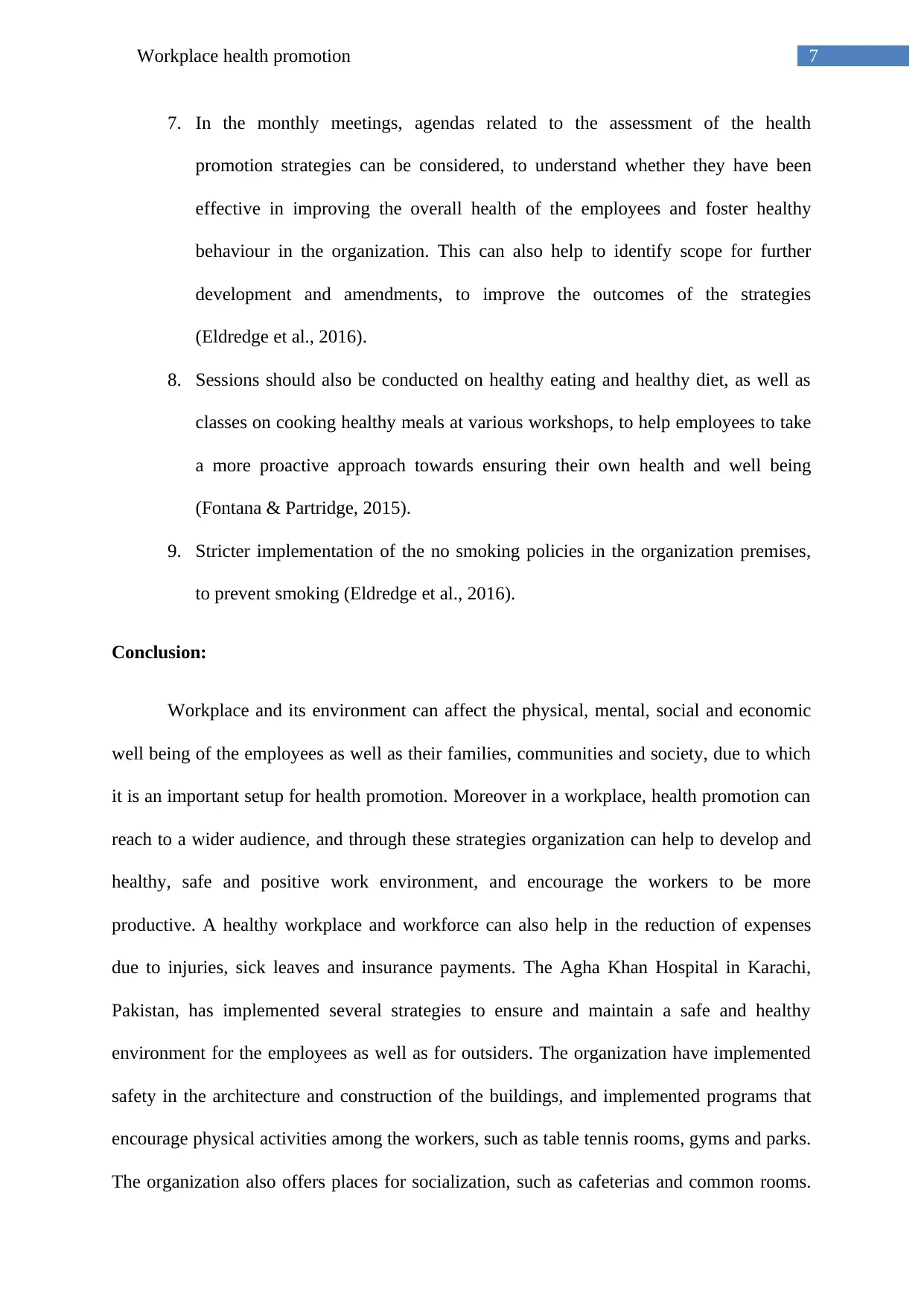
7Workplace health promotion
7. In the monthly meetings, agendas related to the assessment of the health
promotion strategies can be considered, to understand whether they have been
effective in improving the overall health of the employees and foster healthy
behaviour in the organization. This can also help to identify scope for further
development and amendments, to improve the outcomes of the strategies
(Eldredge et al., 2016).
8. Sessions should also be conducted on healthy eating and healthy diet, as well as
classes on cooking healthy meals at various workshops, to help employees to take
a more proactive approach towards ensuring their own health and well being
(Fontana & Partridge, 2015).
9. Stricter implementation of the no smoking policies in the organization premises,
to prevent smoking (Eldredge et al., 2016).
Conclusion:
Workplace and its environment can affect the physical, mental, social and economic
well being of the employees as well as their families, communities and society, due to which
it is an important setup for health promotion. Moreover in a workplace, health promotion can
reach to a wider audience, and through these strategies organization can help to develop and
healthy, safe and positive work environment, and encourage the workers to be more
productive. A healthy workplace and workforce can also help in the reduction of expenses
due to injuries, sick leaves and insurance payments. The Agha Khan Hospital in Karachi,
Pakistan, has implemented several strategies to ensure and maintain a safe and healthy
environment for the employees as well as for outsiders. The organization have implemented
safety in the architecture and construction of the buildings, and implemented programs that
encourage physical activities among the workers, such as table tennis rooms, gyms and parks.
The organization also offers places for socialization, such as cafeterias and common rooms.
7. In the monthly meetings, agendas related to the assessment of the health
promotion strategies can be considered, to understand whether they have been
effective in improving the overall health of the employees and foster healthy
behaviour in the organization. This can also help to identify scope for further
development and amendments, to improve the outcomes of the strategies
(Eldredge et al., 2016).
8. Sessions should also be conducted on healthy eating and healthy diet, as well as
classes on cooking healthy meals at various workshops, to help employees to take
a more proactive approach towards ensuring their own health and well being
(Fontana & Partridge, 2015).
9. Stricter implementation of the no smoking policies in the organization premises,
to prevent smoking (Eldredge et al., 2016).
Conclusion:
Workplace and its environment can affect the physical, mental, social and economic
well being of the employees as well as their families, communities and society, due to which
it is an important setup for health promotion. Moreover in a workplace, health promotion can
reach to a wider audience, and through these strategies organization can help to develop and
healthy, safe and positive work environment, and encourage the workers to be more
productive. A healthy workplace and workforce can also help in the reduction of expenses
due to injuries, sick leaves and insurance payments. The Agha Khan Hospital in Karachi,
Pakistan, has implemented several strategies to ensure and maintain a safe and healthy
environment for the employees as well as for outsiders. The organization have implemented
safety in the architecture and construction of the buildings, and implemented programs that
encourage physical activities among the workers, such as table tennis rooms, gyms and parks.
The organization also offers places for socialization, such as cafeterias and common rooms.
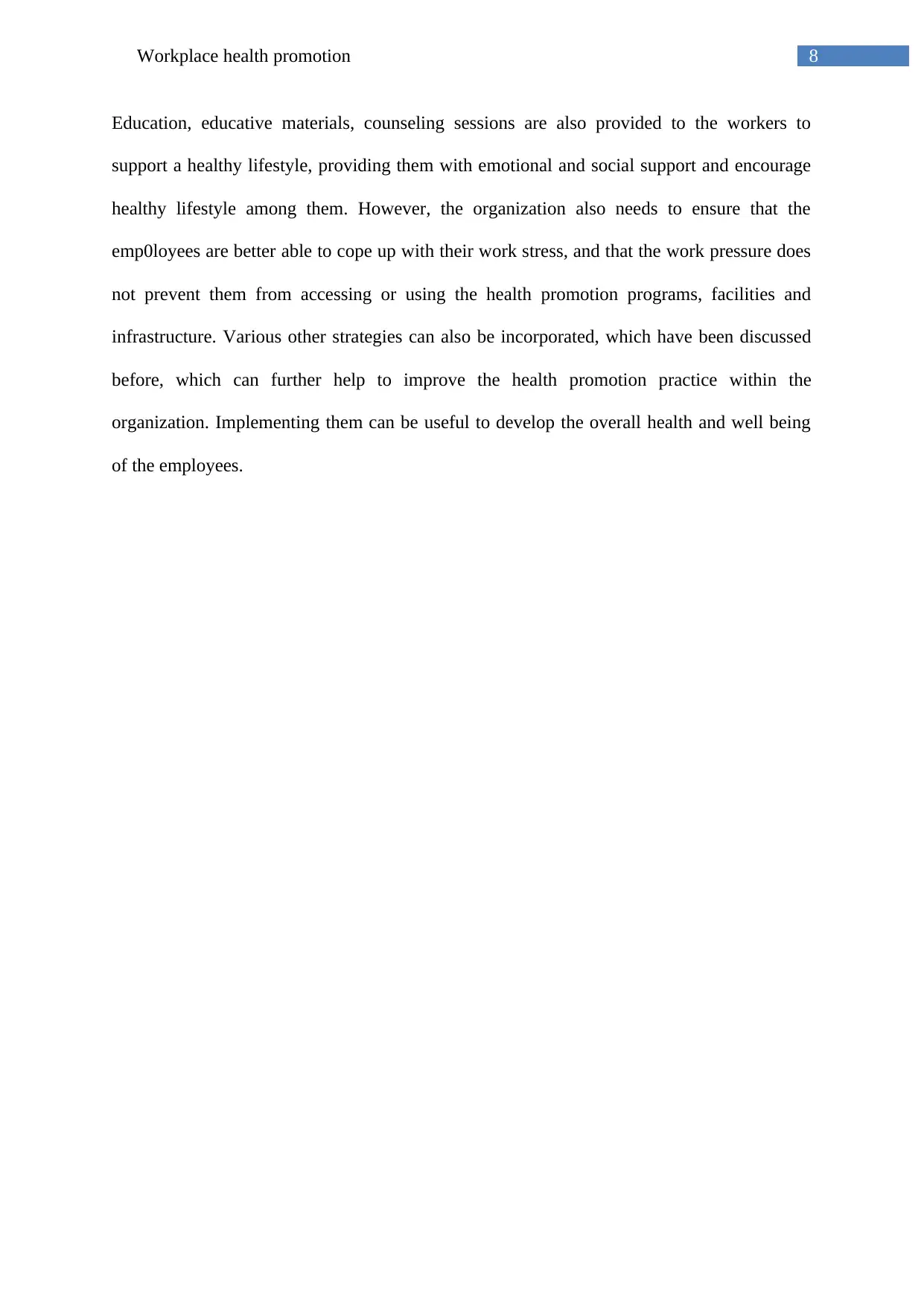
8Workplace health promotion
Education, educative materials, counseling sessions are also provided to the workers to
support a healthy lifestyle, providing them with emotional and social support and encourage
healthy lifestyle among them. However, the organization also needs to ensure that the
emp0loyees are better able to cope up with their work stress, and that the work pressure does
not prevent them from accessing or using the health promotion programs, facilities and
infrastructure. Various other strategies can also be incorporated, which have been discussed
before, which can further help to improve the health promotion practice within the
organization. Implementing them can be useful to develop the overall health and well being
of the employees.
Education, educative materials, counseling sessions are also provided to the workers to
support a healthy lifestyle, providing them with emotional and social support and encourage
healthy lifestyle among them. However, the organization also needs to ensure that the
emp0loyees are better able to cope up with their work stress, and that the work pressure does
not prevent them from accessing or using the health promotion programs, facilities and
infrastructure. Various other strategies can also be incorporated, which have been discussed
before, which can further help to improve the health promotion practice within the
organization. Implementing them can be useful to develop the overall health and well being
of the employees.
⊘ This is a preview!⊘
Do you want full access?
Subscribe today to unlock all pages.

Trusted by 1+ million students worldwide
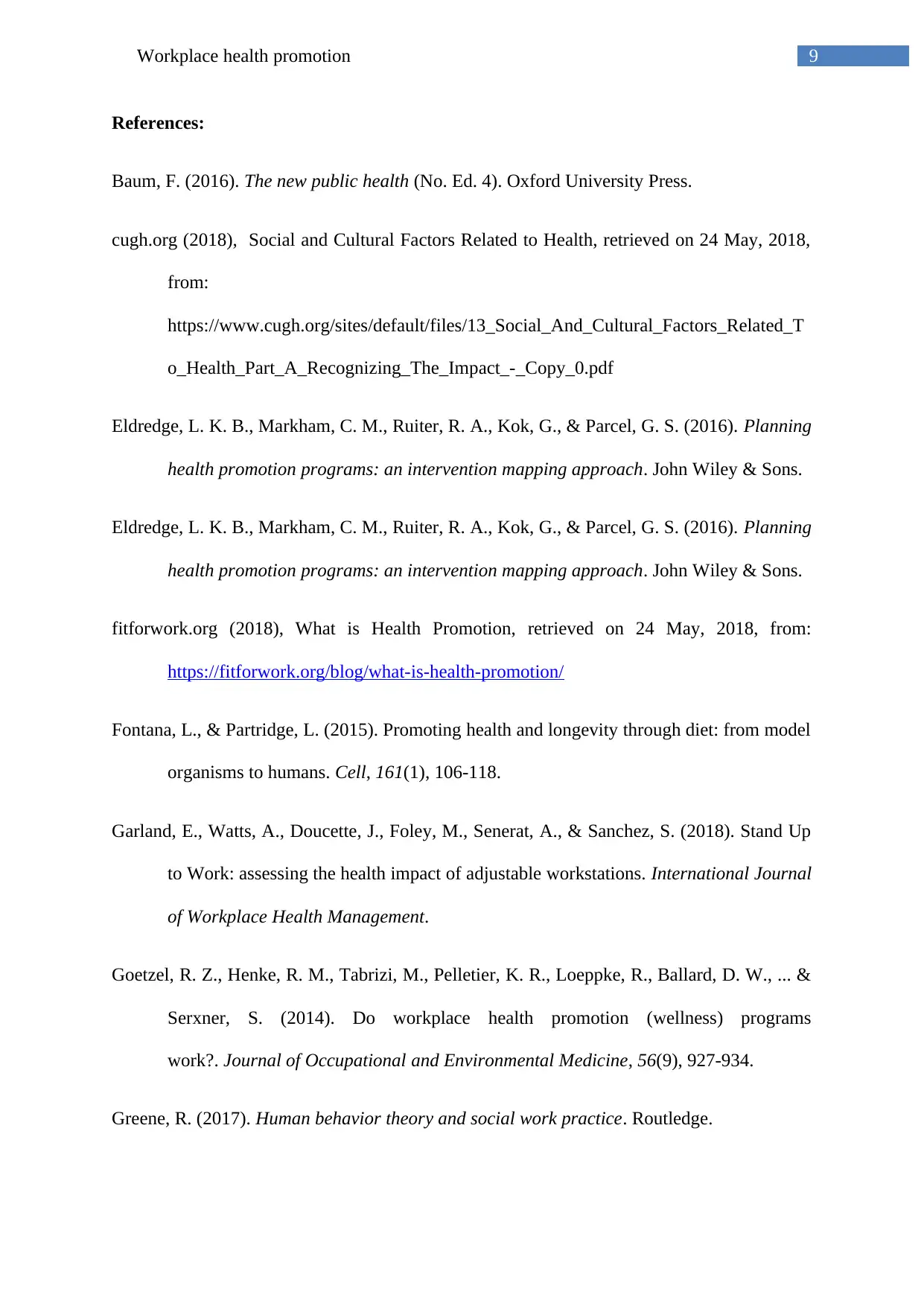
9Workplace health promotion
References:
Baum, F. (2016). The new public health (No. Ed. 4). Oxford University Press.
cugh.org (2018), Social and Cultural Factors Related to Health, retrieved on 24 May, 2018,
from:
https://www.cugh.org/sites/default/files/13_Social_And_Cultural_Factors_Related_T
o_Health_Part_A_Recognizing_The_Impact_-_Copy_0.pdf
Eldredge, L. K. B., Markham, C. M., Ruiter, R. A., Kok, G., & Parcel, G. S. (2016). Planning
health promotion programs: an intervention mapping approach. John Wiley & Sons.
Eldredge, L. K. B., Markham, C. M., Ruiter, R. A., Kok, G., & Parcel, G. S. (2016). Planning
health promotion programs: an intervention mapping approach. John Wiley & Sons.
fitforwork.org (2018), What is Health Promotion, retrieved on 24 May, 2018, from:
https://fitforwork.org/blog/what-is-health-promotion/
Fontana, L., & Partridge, L. (2015). Promoting health and longevity through diet: from model
organisms to humans. Cell, 161(1), 106-118.
Garland, E., Watts, A., Doucette, J., Foley, M., Senerat, A., & Sanchez, S. (2018). Stand Up
to Work: assessing the health impact of adjustable workstations. International Journal
of Workplace Health Management.
Goetzel, R. Z., Henke, R. M., Tabrizi, M., Pelletier, K. R., Loeppke, R., Ballard, D. W., ... &
Serxner, S. (2014). Do workplace health promotion (wellness) programs
work?. Journal of Occupational and Environmental Medicine, 56(9), 927-934.
Greene, R. (2017). Human behavior theory and social work practice. Routledge.
References:
Baum, F. (2016). The new public health (No. Ed. 4). Oxford University Press.
cugh.org (2018), Social and Cultural Factors Related to Health, retrieved on 24 May, 2018,
from:
https://www.cugh.org/sites/default/files/13_Social_And_Cultural_Factors_Related_T
o_Health_Part_A_Recognizing_The_Impact_-_Copy_0.pdf
Eldredge, L. K. B., Markham, C. M., Ruiter, R. A., Kok, G., & Parcel, G. S. (2016). Planning
health promotion programs: an intervention mapping approach. John Wiley & Sons.
Eldredge, L. K. B., Markham, C. M., Ruiter, R. A., Kok, G., & Parcel, G. S. (2016). Planning
health promotion programs: an intervention mapping approach. John Wiley & Sons.
fitforwork.org (2018), What is Health Promotion, retrieved on 24 May, 2018, from:
https://fitforwork.org/blog/what-is-health-promotion/
Fontana, L., & Partridge, L. (2015). Promoting health and longevity through diet: from model
organisms to humans. Cell, 161(1), 106-118.
Garland, E., Watts, A., Doucette, J., Foley, M., Senerat, A., & Sanchez, S. (2018). Stand Up
to Work: assessing the health impact of adjustable workstations. International Journal
of Workplace Health Management.
Goetzel, R. Z., Henke, R. M., Tabrizi, M., Pelletier, K. R., Loeppke, R., Ballard, D. W., ... &
Serxner, S. (2014). Do workplace health promotion (wellness) programs
work?. Journal of Occupational and Environmental Medicine, 56(9), 927-934.
Greene, R. (2017). Human behavior theory and social work practice. Routledge.
Paraphrase This Document
Need a fresh take? Get an instant paraphrase of this document with our AI Paraphraser
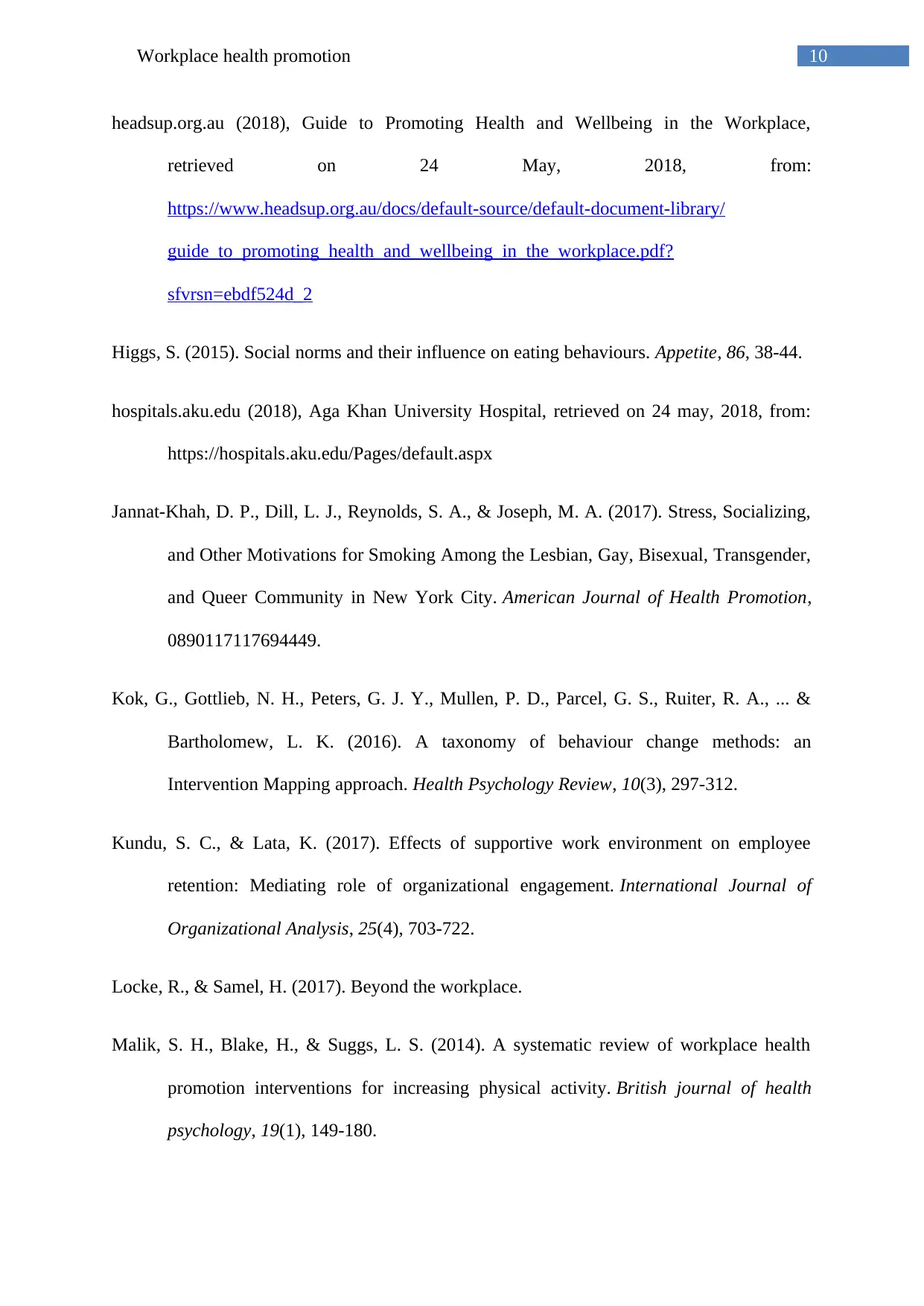
10Workplace health promotion
headsup.org.au (2018), Guide to Promoting Health and Wellbeing in the Workplace,
retrieved on 24 May, 2018, from:
https://www.headsup.org.au/docs/default-source/default-document-library/
guide_to_promoting_health_and_wellbeing_in_the_workplace.pdf?
sfvrsn=ebdf524d_2
Higgs, S. (2015). Social norms and their influence on eating behaviours. Appetite, 86, 38-44.
hospitals.aku.edu (2018), Aga Khan University Hospital, retrieved on 24 may, 2018, from:
https://hospitals.aku.edu/Pages/default.aspx
Jannat-Khah, D. P., Dill, L. J., Reynolds, S. A., & Joseph, M. A. (2017). Stress, Socializing,
and Other Motivations for Smoking Among the Lesbian, Gay, Bisexual, Transgender,
and Queer Community in New York City. American Journal of Health Promotion,
0890117117694449.
Kok, G., Gottlieb, N. H., Peters, G. J. Y., Mullen, P. D., Parcel, G. S., Ruiter, R. A., ... &
Bartholomew, L. K. (2016). A taxonomy of behaviour change methods: an
Intervention Mapping approach. Health Psychology Review, 10(3), 297-312.
Kundu, S. C., & Lata, K. (2017). Effects of supportive work environment on employee
retention: Mediating role of organizational engagement. International Journal of
Organizational Analysis, 25(4), 703-722.
Locke, R., & Samel, H. (2017). Beyond the workplace.
Malik, S. H., Blake, H., & Suggs, L. S. (2014). A systematic review of workplace health
promotion interventions for increasing physical activity. British journal of health
psychology, 19(1), 149-180.
headsup.org.au (2018), Guide to Promoting Health and Wellbeing in the Workplace,
retrieved on 24 May, 2018, from:
https://www.headsup.org.au/docs/default-source/default-document-library/
guide_to_promoting_health_and_wellbeing_in_the_workplace.pdf?
sfvrsn=ebdf524d_2
Higgs, S. (2015). Social norms and their influence on eating behaviours. Appetite, 86, 38-44.
hospitals.aku.edu (2018), Aga Khan University Hospital, retrieved on 24 may, 2018, from:
https://hospitals.aku.edu/Pages/default.aspx
Jannat-Khah, D. P., Dill, L. J., Reynolds, S. A., & Joseph, M. A. (2017). Stress, Socializing,
and Other Motivations for Smoking Among the Lesbian, Gay, Bisexual, Transgender,
and Queer Community in New York City. American Journal of Health Promotion,
0890117117694449.
Kok, G., Gottlieb, N. H., Peters, G. J. Y., Mullen, P. D., Parcel, G. S., Ruiter, R. A., ... &
Bartholomew, L. K. (2016). A taxonomy of behaviour change methods: an
Intervention Mapping approach. Health Psychology Review, 10(3), 297-312.
Kundu, S. C., & Lata, K. (2017). Effects of supportive work environment on employee
retention: Mediating role of organizational engagement. International Journal of
Organizational Analysis, 25(4), 703-722.
Locke, R., & Samel, H. (2017). Beyond the workplace.
Malik, S. H., Blake, H., & Suggs, L. S. (2014). A systematic review of workplace health
promotion interventions for increasing physical activity. British journal of health
psychology, 19(1), 149-180.
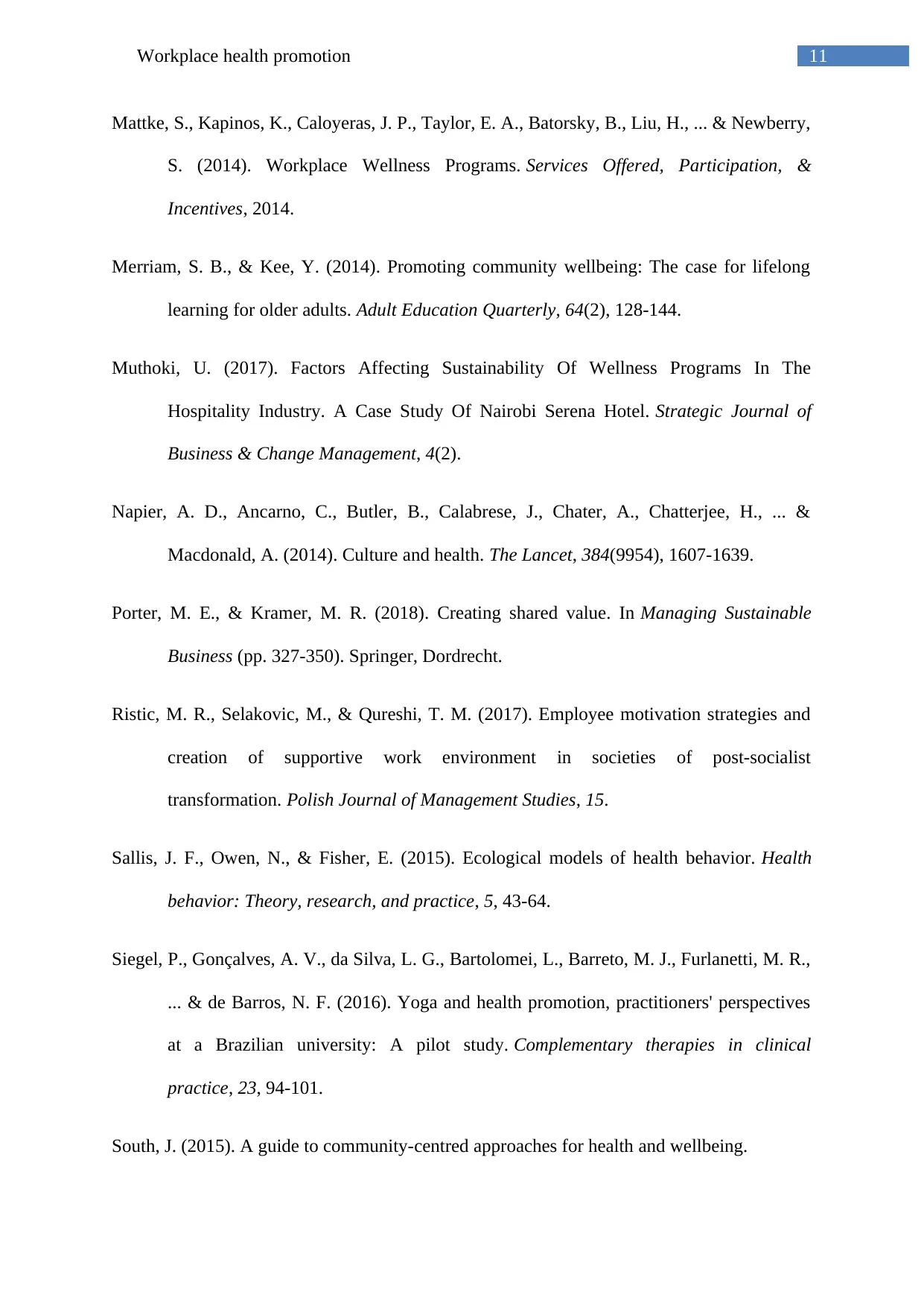
11Workplace health promotion
Mattke, S., Kapinos, K., Caloyeras, J. P., Taylor, E. A., Batorsky, B., Liu, H., ... & Newberry,
S. (2014). Workplace Wellness Programs. Services Offered, Participation, &
Incentives, 2014.
Merriam, S. B., & Kee, Y. (2014). Promoting community wellbeing: The case for lifelong
learning for older adults. Adult Education Quarterly, 64(2), 128-144.
Muthoki, U. (2017). Factors Affecting Sustainability Of Wellness Programs In The
Hospitality Industry. A Case Study Of Nairobi Serena Hotel. Strategic Journal of
Business & Change Management, 4(2).
Napier, A. D., Ancarno, C., Butler, B., Calabrese, J., Chater, A., Chatterjee, H., ... &
Macdonald, A. (2014). Culture and health. The Lancet, 384(9954), 1607-1639.
Porter, M. E., & Kramer, M. R. (2018). Creating shared value. In Managing Sustainable
Business (pp. 327-350). Springer, Dordrecht.
Ristic, M. R., Selakovic, M., & Qureshi, T. M. (2017). Employee motivation strategies and
creation of supportive work environment in societies of post-socialist
transformation. Polish Journal of Management Studies, 15.
Sallis, J. F., Owen, N., & Fisher, E. (2015). Ecological models of health behavior. Health
behavior: Theory, research, and practice, 5, 43-64.
Siegel, P., Gonçalves, A. V., da Silva, L. G., Bartolomei, L., Barreto, M. J., Furlanetti, M. R.,
... & de Barros, N. F. (2016). Yoga and health promotion, practitioners' perspectives
at a Brazilian university: A pilot study. Complementary therapies in clinical
practice, 23, 94-101.
South, J. (2015). A guide to community-centred approaches for health and wellbeing.
Mattke, S., Kapinos, K., Caloyeras, J. P., Taylor, E. A., Batorsky, B., Liu, H., ... & Newberry,
S. (2014). Workplace Wellness Programs. Services Offered, Participation, &
Incentives, 2014.
Merriam, S. B., & Kee, Y. (2014). Promoting community wellbeing: The case for lifelong
learning for older adults. Adult Education Quarterly, 64(2), 128-144.
Muthoki, U. (2017). Factors Affecting Sustainability Of Wellness Programs In The
Hospitality Industry. A Case Study Of Nairobi Serena Hotel. Strategic Journal of
Business & Change Management, 4(2).
Napier, A. D., Ancarno, C., Butler, B., Calabrese, J., Chater, A., Chatterjee, H., ... &
Macdonald, A. (2014). Culture and health. The Lancet, 384(9954), 1607-1639.
Porter, M. E., & Kramer, M. R. (2018). Creating shared value. In Managing Sustainable
Business (pp. 327-350). Springer, Dordrecht.
Ristic, M. R., Selakovic, M., & Qureshi, T. M. (2017). Employee motivation strategies and
creation of supportive work environment in societies of post-socialist
transformation. Polish Journal of Management Studies, 15.
Sallis, J. F., Owen, N., & Fisher, E. (2015). Ecological models of health behavior. Health
behavior: Theory, research, and practice, 5, 43-64.
Siegel, P., Gonçalves, A. V., da Silva, L. G., Bartolomei, L., Barreto, M. J., Furlanetti, M. R.,
... & de Barros, N. F. (2016). Yoga and health promotion, practitioners' perspectives
at a Brazilian university: A pilot study. Complementary therapies in clinical
practice, 23, 94-101.
South, J. (2015). A guide to community-centred approaches for health and wellbeing.
⊘ This is a preview!⊘
Do you want full access?
Subscribe today to unlock all pages.

Trusted by 1+ million students worldwide
1 out of 13
Related Documents
Your All-in-One AI-Powered Toolkit for Academic Success.
+13062052269
info@desklib.com
Available 24*7 on WhatsApp / Email
![[object Object]](/_next/static/media/star-bottom.7253800d.svg)
Unlock your academic potential
Copyright © 2020–2025 A2Z Services. All Rights Reserved. Developed and managed by ZUCOL.




